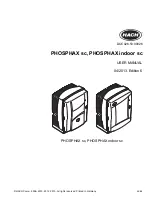
technical reference
61
SYNRAD OEM v40 Operator’s Manual Version 4
Controlling laser power
To generate the correct analog voltage from a computer or PLC, a Digital-to-Analog (D/A or DAC) card
capable of generating 0 V (laser off) to 10 V (maximum laser power) must be installed. To generate the
proper analog current, install a D/A card that can generate 4 mA (laser off) to 20 mA (maximum power).
Software able to control your analog output card is required for either configuration.
Continuous wave (CW)
In some applications, such as high speed marking or cutting, the time constant of the laser and the PWM
modulation causes a series of dots that may be visible on the marking surface instead of a “clean” line.
Operating the laser in CW mode will prevent this behavior from occurring.
To operate the laser in CW mode, apply a co5 VDC signal to Pin 9, PWM Input, and Pin 1, PWM
Return, on the User I/O connector. This constant voltage source forces the internal switching electronics
to remain on, providing continuous and uninterrupted laser output power. During CW operation, output
power cannot be changed. To adjust output power, refer back to the Pulse width modulation (PWM) section
for information about high frequency operation
Note: SYNRAD lasers are designed for maximum performance at a 95% duty cycle. Increasing the
maximum PWM percentage beyond 95% greatly increases the laser’s heat load with little or no
corresponding increase in laser output power. Continuous operation at 99% duty cycle may lead
to thermal instability and optical degradation.
Gated operation
In many marking and cutting applications, the laser is required to pulse, or gate, on and off in synchroni-
zation with an external control signal (typically from a computer or function generator operating in the
range from DC to 1 kHz). To pulse or gate the laser, connect a signal pro5.0 VDC pulses to the
Gate connector on the rear panel of the UC-2000 Universal Laser Controller.
Users who intend to use a gating signal should set the UC-2000’s gate input logic to internal Pull-Down
(normally off) mode. This prevents the beam from being enabled unless a high level (+3.5 V to +5.0
VDC) signal is applied to the Gate input connector. In the pull-down (normally off) mode an asserted
logic low signal, short circuit to ground, or an open or disconnected Gate input locks the beam off.
Warning
serious
personal
injury
The UC-2000’s default gate logic is factory set to internal Pull-Up
(normally on) mode so that an open (disconnected) Gate input
causes the laser to turn on. This functionality allows the user to easily
test and verify laser operation prior to integration.
In an integrated system, you should configure the UC-2000’s gate
input logic to internal Pull-Down (normally off) mode. This prevents
the beam from being enabled unless a high level (+3.5 V to +5.0
VDC) signal is applied to the Gate input connector. In the Pull-
Down (normally off) mode an asserted logic low signal, short circuit
to ground, or an open or disconnected Gate input locks the beam off.
Many CO
2
lasers operating in applications requiring short gating pulses at repetition rates below 500 Hz
will exhibit some leading edge overshoot regardless of the PWM frequency. This occurs because a cooler
lasing medium (the CO
2
gas) is more efficient than a hotter one. The overshoot effect is more pronounced
at lower gating frequencies since the gas has a longer time to cool down between Command signal pulses.
Содержание Firestar V Series
Страница 29: ...getting started 29 SYNRAD OEM v40 Operator s Manual Version 4 This page intentionally left blank ...
Страница 85: ...technical reference 85 SYNRAD OEM v40 Operator s Manual Version 4 This page intentionally left blank ...
Страница 103: ...maintenance troubleshooting 103 SYNRAD OEM v40 Operator s Manual Version 4 This page intentionally left blank ...
















































